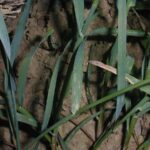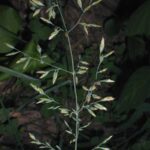Canada Bluegrass
Poa compressa
General Description
Canada bluegrass is a medium-tall species growing seed stalks to 48cm (19 in) long consisting of both fertile and infertile shoots. The leaves are basal, and low growing. It has a creeping root system. It eventually forms a very firm sod from the spread of slender rhizomes. Characteristics of the rhizomes vary with variety. There are numerous other bluegrass species found within Canada. At the bud stage, leaf blades are folded, flat, or V-shaped, and have a boat-shaped tip. Leaf blades when flattened out are 2 to 5 mm (1/16 to 1/5 in) wide. Seed heads form on bluish-coloured triangular-shaped panicles about 5 to 10 cm (2 to 4 in) long.
Canada bluegrass can be distinguished from other bluegrasses (Poa spp.) by its flattened culms and grayish blue or grayish green foliage. Also, its panicle of spikelets has a more narrow shape than those of many other bluegrasses. Another common species, Kentucky bluegrass (Poa pratensis), prefers ground that is more moist, loamy, and fertile. Canada Bluegrass germinates quickly and establishes faster than Kentucky bluegrass.
Type
Tame grass & native grass.
Origin
In spite of its common name, this grass species is native to Eurasia. Habitats include dry rocky woodlands, openings in upland woodlands, upland prairies, upland sand prairies, upland savannas, sandy savannas, areas along railroads, roadsides, sandy camping sites, weedy meadows, pastures, and waste areas. This grass was originally introduced into North America as a source of forage for dry pastures with poor soil. It has since spread into other areas.
Longevity
At least 20 years.
Use
Pasture, reclamation.
.
Optimal Time of Use
Canada bluegrass greens up early in the spring and if fall rains are adequate will make fall growth. Growth during summer is dependent on precipitation. It stays green into late fall and early winter and is tolerant of close grazing and heavy trampling.
Recovery After Use
Highly resistant to grazing once stand is established (though the general regrowth principles will increase yield). Under moist conditions, recovery and regrowth after grazing are quick. Grazing should be deferred on seeded lands for at least two growing seasons to allow for full stand establishment.
Palatability/Nutritional Value
At comparable growth stages, bluegrass contains more energy per pound of dry matter than smooth bromegrass. It is also extremely palatable during periods of rapid growth.
Annual Precipitation min/max (mm)
NA
Drought Tolerance
Good to excellent tolerance.
Flooding Tolerance
Fair tolerance. Withstands up to 2 to 5 weeks of spring flooding and waterlogged soils.
Winter Hardiness
Excellent hardiness.
Soil Texture Preference
Prefers well-drained, fertile, moist soils. Because of its need for moisture, Canada bluegrass often grows better on clay, silty, or peat soils, but can adapt to moist sandy soils.
Erosion Control
Moderate ability to control erosion. Forms a rhizomatous mat once established.
.
Salinity Tolerance
Not tolerant.
Acidity Tolerance
Good to moderate tolerance (BY 5-7pH).
Alkalinity Tolerance
Low tolerance.
Seeds per kg
4,800,000seeds/kg (2,177,000 seeds/lb)
Suggested Mixtures
Can be compatible with legumes such as birdsfoot trefoil, alsike clover, and white clover.
Ease of Establishment
Canada bluegrass easily germinates,and establishes faster than Kentucky bluegrass. Seed should be planted into a clean, firm seedbed to a depth of 1/4 inch. Drilling is preferred to ensure uniform seeding depth but broadcast seeding followed by harrowing and packing can be utilized where soil moisture is not lacking. Canada bluegrass can be slower to establish when broadcast seeded. Early spring seeding is preferred. Late summer (if soil moisture is adequate) and dormant fall seeding can be successful.
Competitiveness
Highly competitive. It is listed as invasive and “potentially of national concern”(Native Plant Database 2015). Its competitiveness means that it can invade pastures and native range, especially when closely grazed. It can persist in the lower part of the plant community and increases as taller species decline.
Management Considerations
Select variety based on performance traits that are desired, such as yield. Canada bluegrass will tolerate high traffic and grazing.
NA

